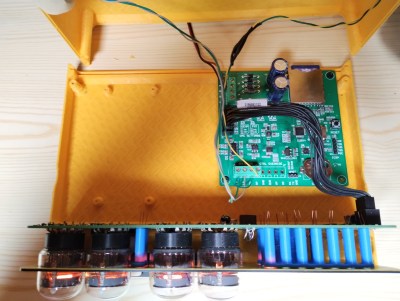We feature a lot of clocks here at Hackaday, but alarm clocks seem to be less popular for some reason. Maybe that’s because no-one enjoys being woken up in the morning, or simply because everyone uses their smartphone for that purpose already. In any case, we’re delighted to bring you [Manuel Tosone]’s beautiful Nixie tube alarm clock that cleverly combines modern and classic technologies in a single package.
 The clock and alarm functionalities are implemented by a PIC24 microcontroller on a custom mainboard. It keeps track of time through its real-time clock with battery backup, and plays a song from an SD card when it’s time to wake up. A 2 x 3 W class D audio amplifier plus a pair of stereo speakers should be able to wake even the heaviest sleepers.
The clock and alarm functionalities are implemented by a PIC24 microcontroller on a custom mainboard. It keeps track of time through its real-time clock with battery backup, and plays a song from an SD card when it’s time to wake up. A 2 x 3 W class D audio amplifier plus a pair of stereo speakers should be able to wake even the heaviest sleepers.
Of course, the real party piece is the clock’s display: four IN-4 Nixie tubes show the time, with neon tubes indicating the day of the week. The 180 V needed for the Nixies is generated by an MC34063A-based boost converter, which also powers the neon tubes.
Instead of using the standard current-limiting resistor for each Nixie tube, [Manuel] designed an array of transistor-based current sources: this enables linear control of the tubes’ brightness, and should keep the amount of light constant even as the tubes age. The individual segments are switched by SN75468 Darlington arrays, with no need for those hard-to-find SN74141 drivers.
The mainboard and the display are housed inside a 3D-printed case that mimics the style of 1980s digital alarm clocks, but with a nice 1970s twist courtesy of those Nixie tubes. [Manuel]’s GitHub page has all the schematics as well as extensive documentation describing the circuit’s operation — an excellent resource if you’re planning to build a Nixie project yourself. If Nixies aren’t your thing, you can also make an alarm clock with a VFD tube, or even roll your own luminous analog dial.















If I used my smartphone to wake me up, then what would the alarm clock be used for?
A phone cannot substitute a good wristwatch or alarm :^)
time from GPS please
Those buttons do not look ergonomic.
Alarm clocks need buttons that can withstand being thrown across the room.
It uses a very common mc34063 in a way i’ve never seen before. It’s none of the classical schematics (from datasheet, step up/down and inverter). And moreover, the mc34063 is not rated for 180V afaics. I know the mc34063 is very versatile, providing the basic ‘building blocks’ for lot of different kind of dc-dc converters. I guess this is one of those less-standard case. I don’t understand it fully though :-( (yet).
The circuit is very similar to Onsemi’s datasheet of the MC34063 (Page 6). The BJT and diode connected to the MOSFET’s gate provide a faster method of discharging the gate capacitance than a lone resistor would. The MC34063 doesn’t have a way to discharge the MOSFET when it’s drive transistor turns off.
It is a standard boost configuration, but it uses an external mosfet because the internal switch is not rated for 180V. The added PNP transistor is to quickly discharge the gate of the mosfet during the off period so as not to leave the mosfet partially on and waste efficiency. Such a circuit is reported in the datasheet of some MC34063 manufacturers, the ST datasheet has it.
Unfortunately those IN-4 tubes have a pretty short lifespan compared to other nixie tubes which contain mercury, hope they’ve got spares.
Yeah. I had 4 sitting in a clock, after half a year they started having internal shorts i had to blow away with a capacitor. After a year i gave up and replaced the tubes. They were nicely silvered on the inside. They are only good for very occasional use. Once there is mercury in the tubes, they literally last a decade at least.
good to know; thanks!
Save your money buy a tube one with mercury in it nicecn toxic